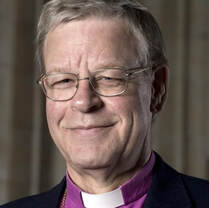| Alan Garrow Didache |
Erik Aurelius

Erik Aurelius was Professor of Biblical Theology at Goettingen University, Germany, 1997-2004 and Bishop of Skara Diocese, Sweden, 2004-2012.
In 2001 he wrote in support of Matthew's direct knowledge of Luke (and the Q tradition[s]): "Gottesvolk und Auiienseiter: Eine geheime Beziehung Lukas— Matthaus." New Testament Studies 47 (2001): 428-41.
"I have read my NTS-article from 2001 again and now I remember.
What put me on the track was the astonishing correspondence between Lk 4:25–27 about the widow in Zarephath in Sidon with a sick child and the pagan officer Naaman on the one hand and on the other hand Mt 8:5–13 about the pagan officer and Mt 15:21–28 about the woman in the district of Tyre and Sidon with a sick child. Only Matthew has both these stories and the Mt-redaction has assimilated them to each other, especially through putting in the "great faith" at the end, in 15:28 (not in Mark 7:24–30 – but in Mt 8:10), making these two pagans, one man and one woman, the only two persons whom Jesus praises for their great faith. Matthew obviously wants the stories to be seen as a pair that belongs together, as the two OT counterparts do in Luke 4:25–27. The Mt-redaction also put in "Sidon" at the beginning, in Mt 15:21, not mentioned in Mk 7:24, but in Lk 4:26 – a sign that Mt also wants us to see the connection between the two NT-pagans and their OT counterparts mentioned in Lk 4:25–27. That was and is enough to convince me that Matthew knew the saying Luke 4:25–27. My reasons are elaborated in paragraphs II-IV (pp. 431-436). And my explanation of the fact that Matthew does not render the saying himself, although it seems to be so important to him, is presented in paragraph VI (p. 439f). In short: he did not want to contradict the program as it is expressed in Mt 10:5f (and 15:24): first to Israel. But he also wanted to show how the incalculable reality, i.e. the surprising great faith of two pagans overcame the program.
If this were the only evidence it might, however, also be explained through the assumption that Matthew just knew (the tradition behind) the saying recorded in Luke 4:25–27, not necessarily the whole Gospel of Luke. The tradition could be Syrian, as both examples are connected to Syria – and Mt is often presumed to emanate from Syria (p. 438). But I was more impressed and convinced especially by von Dobschuetz, Hengel and Huggins, and the last years even more by Garrow, that Mt in fact knew the whole of Luke (as well as the Q-tradition[s], p. 439 n. 41)."
More MPH Origin Stories
In 2001 he wrote in support of Matthew's direct knowledge of Luke (and the Q tradition[s]): "Gottesvolk und Auiienseiter: Eine geheime Beziehung Lukas— Matthaus." New Testament Studies 47 (2001): 428-41.
"I have read my NTS-article from 2001 again and now I remember.
What put me on the track was the astonishing correspondence between Lk 4:25–27 about the widow in Zarephath in Sidon with a sick child and the pagan officer Naaman on the one hand and on the other hand Mt 8:5–13 about the pagan officer and Mt 15:21–28 about the woman in the district of Tyre and Sidon with a sick child. Only Matthew has both these stories and the Mt-redaction has assimilated them to each other, especially through putting in the "great faith" at the end, in 15:28 (not in Mark 7:24–30 – but in Mt 8:10), making these two pagans, one man and one woman, the only two persons whom Jesus praises for their great faith. Matthew obviously wants the stories to be seen as a pair that belongs together, as the two OT counterparts do in Luke 4:25–27. The Mt-redaction also put in "Sidon" at the beginning, in Mt 15:21, not mentioned in Mk 7:24, but in Lk 4:26 – a sign that Mt also wants us to see the connection between the two NT-pagans and their OT counterparts mentioned in Lk 4:25–27. That was and is enough to convince me that Matthew knew the saying Luke 4:25–27. My reasons are elaborated in paragraphs II-IV (pp. 431-436). And my explanation of the fact that Matthew does not render the saying himself, although it seems to be so important to him, is presented in paragraph VI (p. 439f). In short: he did not want to contradict the program as it is expressed in Mt 10:5f (and 15:24): first to Israel. But he also wanted to show how the incalculable reality, i.e. the surprising great faith of two pagans overcame the program.
If this were the only evidence it might, however, also be explained through the assumption that Matthew just knew (the tradition behind) the saying recorded in Luke 4:25–27, not necessarily the whole Gospel of Luke. The tradition could be Syrian, as both examples are connected to Syria – and Mt is often presumed to emanate from Syria (p. 438). But I was more impressed and convinced especially by von Dobschuetz, Hengel and Huggins, and the last years even more by Garrow, that Mt in fact knew the whole of Luke (as well as the Q-tradition[s], p. 439 n. 41)."
More MPH Origin Stories